tire size CHEVROLET S10 1993 2.G Owners Manual
[x] Cancel search | Manufacturer: CHEVROLET, Model Year: 1993, Model line: S10, Model: CHEVROLET S10 1993 2.GPages: 356, PDF Size: 20.85 MB
Page 212 of 356
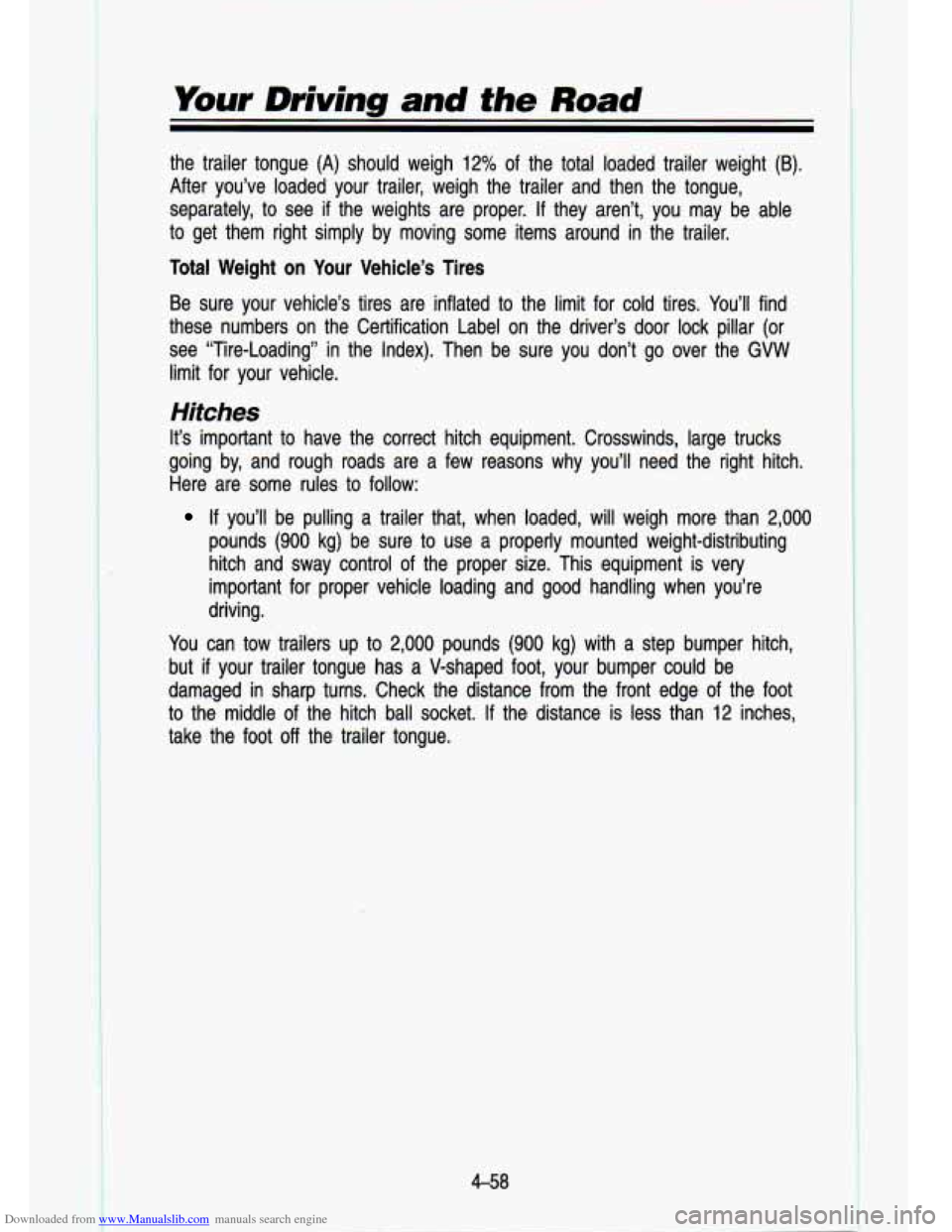
Downloaded from www.Manualslib.com manuals search engine Your Driving and the Road
the trailer tongue (A) should weigh 12% of the total loaded trailer weight (B).
After you’ve loaded your trailer, weigh the trailer and then\
the tongue,
separately,
to see if the weights are proper. If they aren’t, you may be able
to get them right simply by moving some items around in the trai\
ler.
Total Weight
on Your Vehicle’s Tires
Be sure your vehicle’s tires are inflated
to the limit for cold tires. You’ll find
these numbers on the Certification Label on the driver’s doo\
r lock pillar (or see “Tire-Loading” in the Index). Then be sure you don’\
t go over the GVW
limit for your vehicle.
Hitches
It’s important to have the correct hitch equipment. Crosswind\
s, large trucks
going by, and rough roads are a few reasons why you’ll need the right hitch.
Here are some rules to follow:
If you’ll be pulling a trailer that, when loaded, will weigh more than 2,000
pounds (900 kg) be sure to use a properly mounted weight-distributing
hitch and sway control
of the proper size. This equipment is very
important for proper vehicle loading and good handling when you\
’re
driving.
You can tow trailers up to
2,000 pounds (900 kg) with a step bumper hitch,
but
if your trailer tongue has a V-shaped foot, your bumper could be
damaged in sharp turns. Check the distance from the front edge of the fo\
ot
to the middle of the hitch ball socket. If the distance is less than 12 inches,
take the foot
off the trailer tongue.
Page 244 of 356
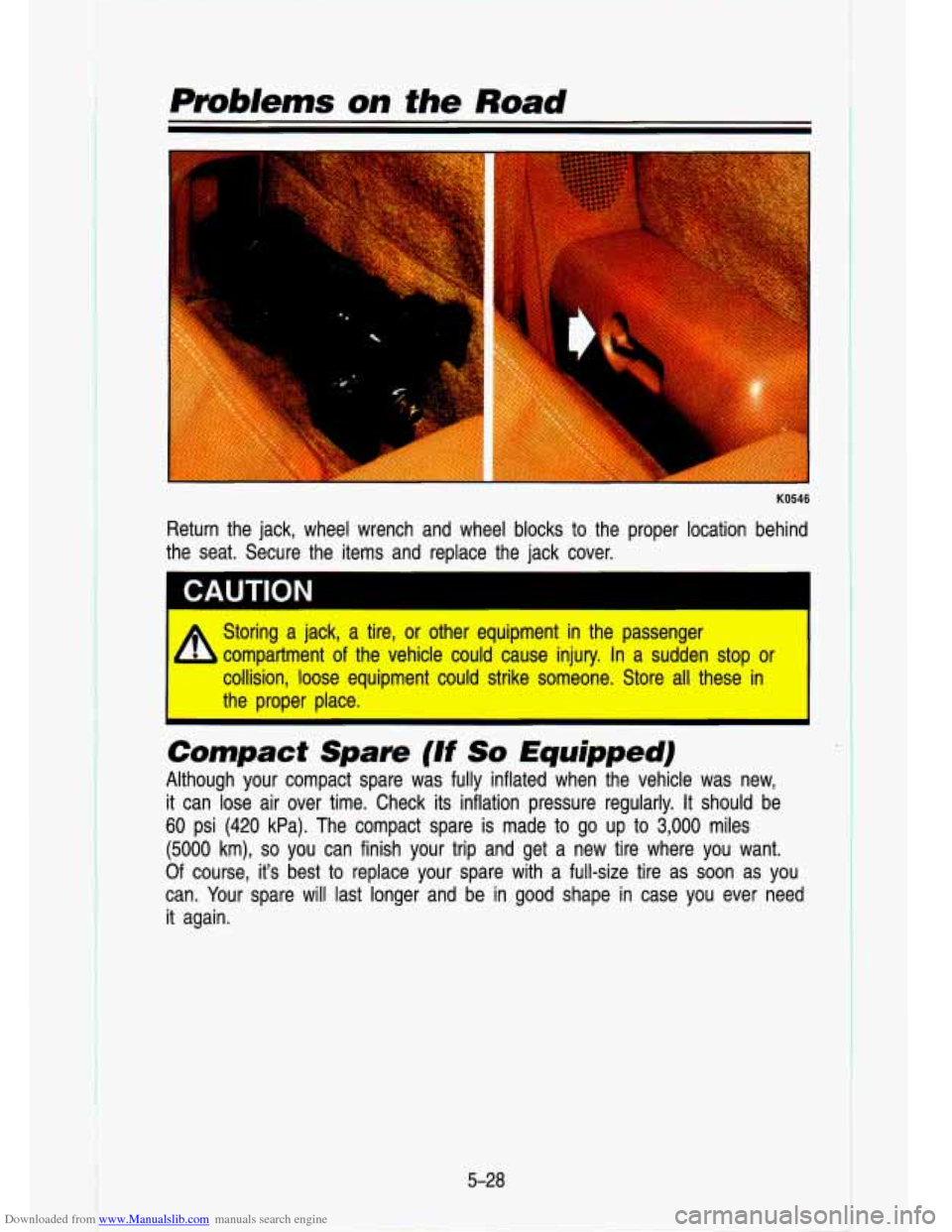
Downloaded from www.Manualslib.com manuals search engine Problenrs on the Road
KO546
Return the jack, wheel wrench and wheel blocks to the proper \
location behind
the seat. Secure the items and replace the jack cover.
Storing a jack, a tire, or other equipment in the passenger
compartment of the vehicle could cause injury. In a sudden stop or
collision, loose equipment could strike someone. Store all these\
in
I the proper place.
Compact Spare (If So Equipped)
Although your compact spare was fully inflated when the vehicle\
was new,
it can lose air over time. Check its inflation pressure regularly.\
It should be
60 psi (420 kPa). The compact spare is made to go up to 3,000 miles
(5000 km), so you can finish your trip and get a new tire where you want.
Of course, it's best to replace your spare with
a full-size tire as soon as you
can. Your spare will last longer and be in good shape in case you ever need
it again.
5-28
Page 294 of 356
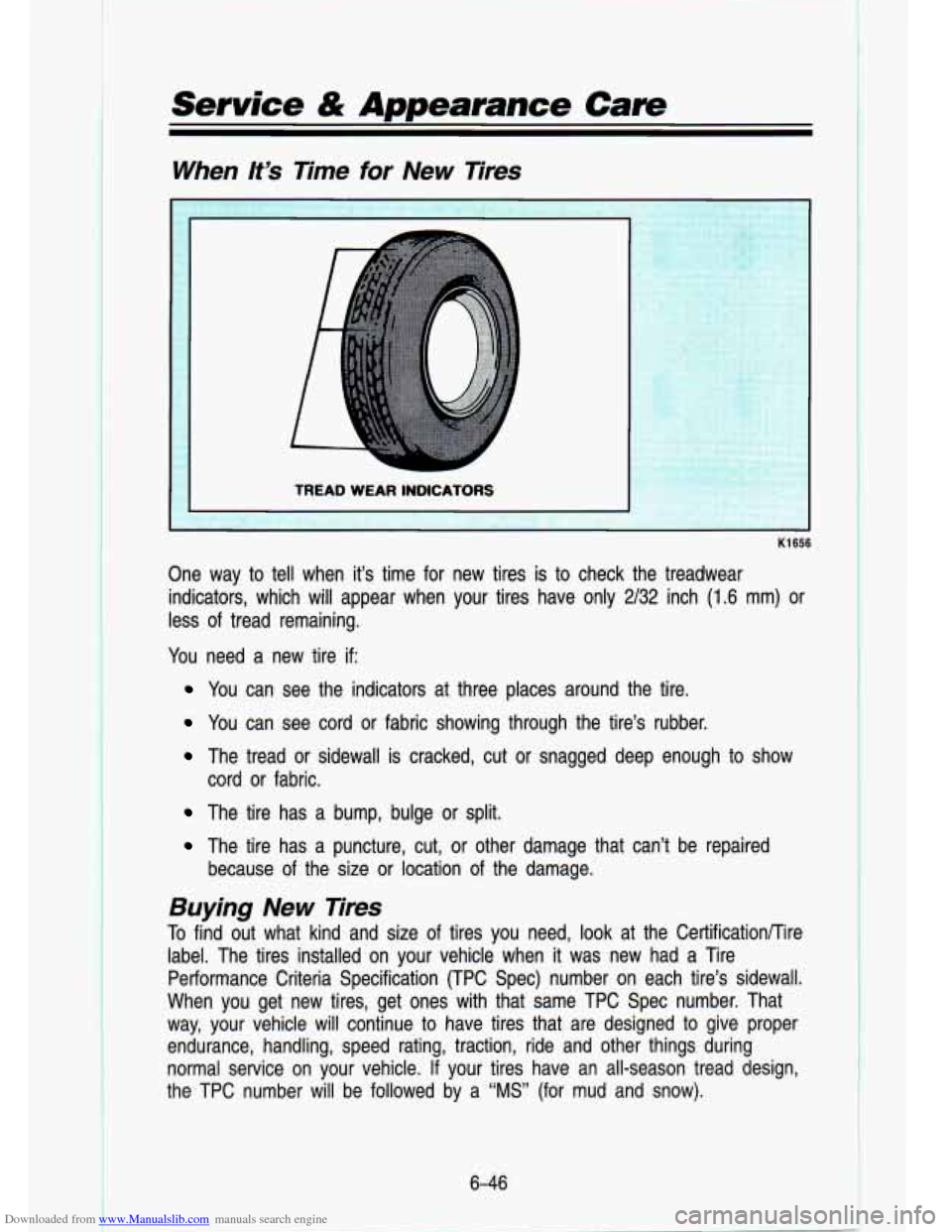
Downloaded from www.Manualslib.com manuals search engine Service & Appearance Care
When It’s Time for New Tires
K1656
One way to tell when it’s time for new tires is to check the treadwear
indicators, which will appear when your tires have only
2/32 inch (1.6 mm) or
less of tread remaining.
You need a new tire
if:
You can see the indicators at three places around the tire.
You can see cord or fabric showing through the tire’s rubber.
The tread or sidewall is cracked, cut or snagged deep enough to show
cord or fabric.
The tire has a bump, bulge or split.
The tire has a puncture, cut, or other damage that can’t b\
e repaired
because of the size
or location of the damage.
Buying New Eres
To find out what kind and size of tires you need, look at the CertificationRire
label. The tires installed on your vehicle when it was mew had a Tire
Performance Criteria Specification (TPC Spec) number on each t\
ire’s sidewall.
When you get new tires, get ones with that same TPC Spec num\
ber. That
way, your vehicle will continue to have tires that are designed to give proper
endurance, handling, speed rating, traction, ride and other thin\
gs during
normal service on your vehicle.
If your tires have an all-season tread design,
the TPC number
will be followed by a “MS” (for mud and snow).
6-46
Page 295 of 356
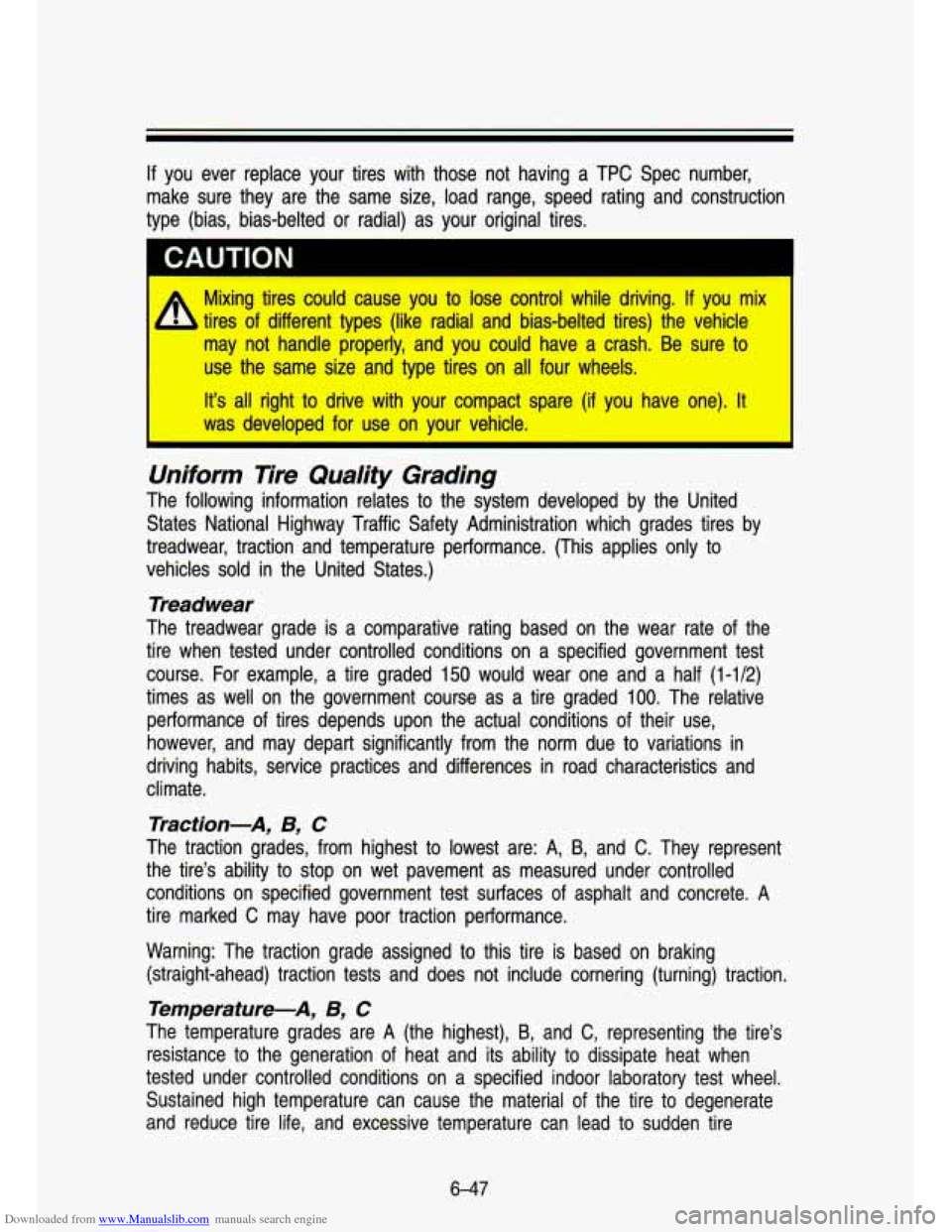
Downloaded from www.Manualslib.com manuals search engine If you ever replace your tires with those not having a TPC Spec number,
make sure they are the same size, load range, speed rating an\
d construction
type (bias, bias-belted or radial) as your original tires.
Mixing tires
could cause you to lose control while driving. If you mix
tires of different types (like radial and bias-belted tires) the vehicl\
e
may nlot handle properly, an'd you could have a cras'h. Be sure to
use the same size 'and type tires on all four wheels.
It's all right to drive with your compact spare (if you have one). It
I was developed for use on your vehicle.
Uniform Tire Quality Grading
The following information relates to the system developed by th\
e United
States National Highway Traffic Safety Administration which grade\
s tires by
treadwear, traction and temperature performance. (This applies o\
nly to
vehicles
sold in the United States.)
Treadwear
The treadwear grade is a comparative rating based on the wear rate of the
tire when tested under controlled conditions on a specified government test
course. For example, a tire graded
150 would wear one and a half (1 -1/2)
times as well on the government course as a tire graded 100. The relative
performance of tires depends upon the actual conditions of their use,
however, and may depart significantly from the norm due to var\
iations in
driving habits, service practices and differences in road charac\
teristics and
climate.
Traction-A, B, C
The traction grades, from highest to lowest are: A, B, and C. They represent
the tire's ability to stop on wet pavement as measured under controlled
conditions on specified government test surfaces of asphalt and concrete.
A
tire marked C may have poor traction performance.
Warning: The traction grade assigned to this tire is based on braking
(straight-ahead) traction tests and does not include cornering \
(turning) traction.
Temperature-A, B, C
The temperature grades are A (the highest), B, and C, representing the tire's
resistance
to the generation of heat and its ability to dissipate heat when
tested under controlled conditions on a specified indoor laboratory test wheel,
Sustained high temperature can cause the material of the tire
to degenerate
and reduce tire life, and excessive temperature can lead to sudden tire
6-47
Page 304 of 356
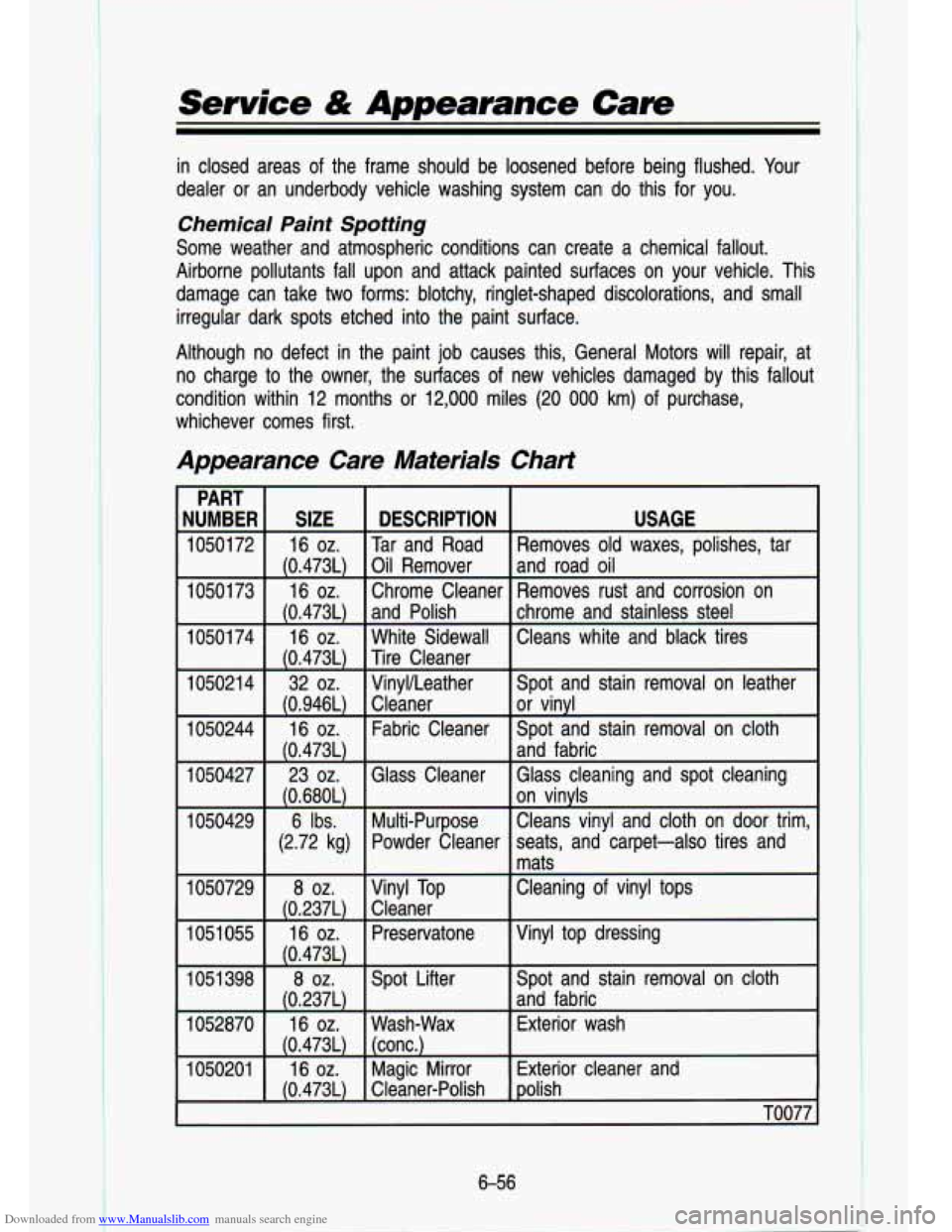
Downloaded from www.Manualslib.com manuals search engine Service & Appearance Care
in closed areas of the frame should be loosened before being flushed. Your
dealer or an underbody vehicle washing system can
do this for you.
Chemical Paint Spotting
Some weather and atmospheric conditions can create a chemical f\
allout.
Airborne pollutants fall upon and attack painted surfaces on your vehicle. This
damage can take two forms: blotchy, ringlet-shaped discolorations\
, and small irregular dark spots etched into the paint surface.
Although no defect in the paint job causes this, General Motors will repair, at
no charge
to the owner, the surfaces of new vehicles damaged by this fallout
condition within 12 months or 12,000 miles (20
000 km) of purchase,
whichever comes first.
Appearance Care Materials Chart
PART
NUMBER SIZE DESCRIPTION
1050172 16
oz. Tar and Road
(0.473L) Oil
Remover
1050173 16
oz. Chrome Cleaner
(0.473L) and Polish
1050174 16
oz. White Sidewall
(0.473L) Tire Cleaner
1050214 32
oz. VinyVLeather
(0.946L) Cleaner
1050244 16
oz. Fabric Cleaner
(0.473L) USAGE
Removes
old waxes, polishes, tar
and road oil
~~ ~~
Removes rust and corrosion on
chrome and stainless steel
Cleans white and black tires
Spot and stain removal on leather
or vinvl
Spot and stain removal on cloth
and fabric
1050427 23
oz. Glass Cleaner Glass cleaning and spot cleaning
(0.680L) on vinyls
1050429
6 Ibs.
(2.72 kg)
1050729 8
oz.
(0.237L)
1051055 16 oz.
(0.473L)
1051398 8
oz.
(0.237L)
1052870 16
oz.
(0.473L)
1050201 16
oz.
(0.473L) Multi-Purpose
Powder Cleaner
Vinyl Top
Cleaner
Preservatone
Spot Lifter
Wash-Wax (conc.)
Magic Mirror
Cleaner-Polish Cleans vinyl and cloth on door trim,
seats, and carpet-also tires and
mats
Cleaning of vinyl tops
Vinyl top dressing Spot and stain removal on cloth
and fabric
Exterior wash
~~
Exterior cleaner and
polish
~nn77
6-56